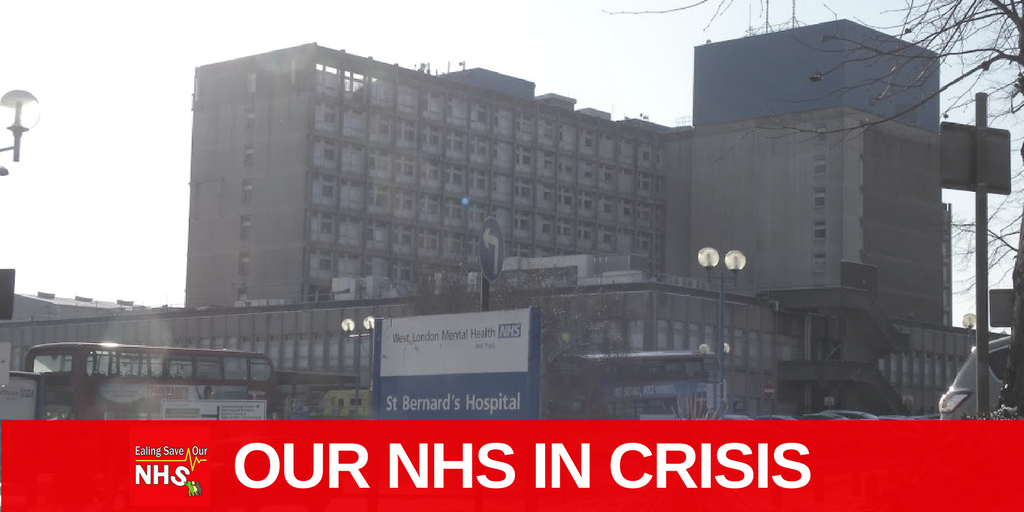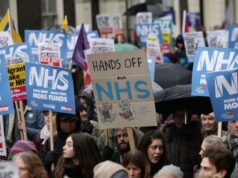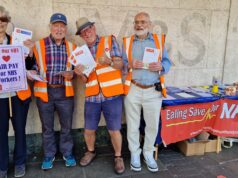NHSI (London) and NHSE (London) Directors of Finance Write to Ealing Save Our NHS (ESON)
In November 2017 NHS Improvement (London) and NHS England (London) Directors of Finance wrote to NHS North West London (NWL) rejecting the NHS NWL ‘Shaping a Healthier Future’ (SaHF) business case ImBC SOC1. This business case requested £513 million for building work connected with plans to close down Ealing District General Hospital. On 6 February 2018 the ESON Research Team wrote to the NHSI/NHSE Directors expressing concerns about the lack of evidence to support the SaHF changes. Specifically ESON found no proof to support the theory that annual Non-Elective hospital admissions (so called NELs) across the eight boroughs in North West London could be reduced by 40% (i.e. by 99,000) by 2025/26.
On 21 February 2018 the Directors wrote to ESON noting the contents of the ESON letter and stating:
‘We would like to assure you therefore, that proposals for significant changes to the provision of health services will need to meet a high assurance bar and be deliverable’.
Hammersmith & Fulham GP Federation and Four NHS Trusts on Track for ‘£200 Million to £300 Million’ for an ‘Accountable Care System’ (ACS)
‘Pulse’ has revealed this deal which is shocking in so many ways. Dr John Sanfey, Medical Director of Hammersmith & Fulham GP Federation, is the mouth piece in the article. For starters the federation is not a statutory body. Why the wild variation in the budget? Will the ACS ‘commission’ physical health, mental health and social care for 212,000 residents? Dr Sanfey is aiming for ‘partial integration’ in 2019. What does that mean? Where is the NHS CCG in all this? Where is the London Borough of Hammersmith & Fulham in all this? Where is the public engagement in all this? Dr Sanfey says that an ‘alliance agreement’ will be signed in April 2018.
Dr Sanfey MB BA BAO BCh DCCH FRCGP appears to be a freelance GP. He is a member of Pallant Medical Chambers based in Chichester. Pallant appears to be a GP locum agency. Pallant employs 125 people and has offices in Southampton and Twickenham.
Hammersmith & Fulham GP Federation is a rather secretive, private limited company (H&FGPF Ltd). It does not have a web site. CQC data reveals that it runs the Brook Green Medical Centre. H&FGPF Ltd’s registered address is 20 Dawes Road, Fulham, SW6 7EN. According to Companies House Dr Sanfey is not an Officer of H&FGPF Ltd.
ECCG OOH Services Single Supplier
A prospectus on this has been published.
What the document is not is an Invitation to Tender (ITT). It’s more of an ‘engagement’ document at the formative stage of contract writing. What the prospectus says, in effect, is that the Ealing Clinical Commissioning Group (ECCG) is thinking about outsourcing the delivery and management of 36 care services. However the ECCG reserves the right to vary the range of services and the nature in which it might outsource them. One assumes that the prospectus might stimulate the nine NHS Trusts and the eight private care providers that ECCG variously entertained on 19 September 2017 and 2 October 2017 to some kind of response of continuing interest.
The contract will be for 10 years and will be in excess of £1 billion. The scheduled start date is April 2019. The prospectus was briefly presented in public on 28 February 2018. 24 members of the ECCG Governing Body approved it at this briefing. Public questioning revealed that no cost saving were envisioned. Cost savings would accrue, allegedly, from reduced Emergency hospital admissions (so called Non-Elective admissions or NELs).
The care flavour of the decade (along with privatisation) is integrated healthcare and social care services delivery. If you are looking for lots of this in the prospectus you will be disappointed. The prospectus is clearly written from a healthcare perspective and its integration with social care is never consistently referenced.
No Simple numeric Performance Metrics
There are no references to any performance metrics. However adhering to the, as yet unapproved, 2012 NHS NWL ‘Shaping a Healthier Future’ (SaHF) business case no doubt the single supplier will have to deliver Ealing’s share of reductions in NELs (Non-Elective admissions to hospitals). Out of the regional total of an annual reduction of 99,000 NELs by 2025/26 Ealing will have to pro rata ‘deliver’ a total of 12,375 of them. On page 41 under ‘Non-Elective Requirements’ we have an ominous phrase ‘Table to be inserted’. At the ECCG meeting in public on 28 February 2018, ECCG said that NELs reduction targets would be inserted on 22 March 2018 in the next public OOH Single Supplier document.
There’s also no reference to how the 10 year contract might relate to the OOH component of the NHS NWL Integrated Care System (ICS) – previously called the Accountable Care System – which no doubt will become a reality before 2029.
No Financial Details
There are no financial details in the prospectus. Trying to find out historic annual OOH service spends in Ealing is far from straightforward. Dr Parmar of ECCG wrote to an Ealing resident on 8 September 2017 and told him that the OOH services spend for Ealing in 2017/18 would be £121.794 million. 10 times that results in a £1.2+ billion contract.
Now some detailed comments:
+ Page 3:
It says the underpinning business case is not for public release. I wonder why that is. It can hardly be commercial in confidence.
It says that OOH services have been fragmented, complex and difficult to navigate for the service user and health and social care staff. (How it would know this about social care services is hard to fathom as they are commissioned by the London Borough of Ealing (LBE)).
Telephone Triage
The triage for all OOH services will be on the phone via the Single Point of Access (now re-named the Community Single Point of Access). The current SPA for mental health service users is not clinically supported 24/7. I know this from direct experience and from other carers. For a Community SPA to operate successfully 24/7 for physical health, mental health, social care and their integration with expert support would be a difficult and expensive service to create and maintain.
The sharing of care plans makes an appearance here as does ‘IT functionality of the Community SPA’. The idea of all 434,000 patients registered at the 76 Ealing GP surgeries all having care plans is hard to imagine. NHS and Local Authorities sharing care plans (the former with healthcare plans, the latter with social care plans) is again quite a leap of faith. Of course the social care service users are part of a different database of 349,000 Ealing residents. No explanation or even description of the challenges of the dichotomy and legality of the healthcare and social care database sharing is even entered into.
Underestimated Population Growth
+ Page 5:
There is a description of Ealing’s current and future population. The future population figures are understated. Mayor Khan’s new 2018 draft London Plan requires LBE to build 28,000 new homes in Ealing 2019 to 2029. This will add some 84,000 new residents. So the social care database will rise to 433,000 and the healthcare database to 518,000.
There is a discussion here about nursing homes, but care homes and domiciliary staff are not mentioned. Yet another integrated healthcare and social care omission.
+ Page 9:
SaHF makes an appearance here. Its business case requires the closure of Ealing District General Hospital (EDGH) by 2021. £513 million for building works is requested to create Ealing healthcare hubs and extend Ealing GP surgeries – all to enable Ealing OOH services to ‘replace’ Acute hospital care in Ealing. But in November 2017, NHS Improvement (London) and NHS England (London) both rejected the SaHF business case.
Although there are explicit sections on ‘Community Care’ and ‘Adult Care’ here, there are no explicit sections on ‘Child Care’, ‘Mental Health’, ‘Social Care’ and ‘Integrated Healthcare and Social Care’. This is worrying.
(Social care is described later in the prospectus under ‘Local Authority’ suggesting that integration of the two care services is not in place).
+ Page 10:
Here we find aspirational stuff including the phrases ‘advance towards’, ‘decisive steps’, and ‘a new deal’. They add little value to the prospectus.
The Manchester and Dudley Vanguard Multispeciality Providers (MCPs) ICSs are mentioned in a positive light. Surprising this, as all three of these grant funded projects have been halted.
‘…(Current) improvements to OOH services throughout the borough’. The only measureable, tangible OOH services’ improvement in Ealing mentioned by Dr Parmar in her letter of 8 September 2017 was ‘(Home Ward) service apparently helping to avoid 1,400 hospital admissions over an eight month period’. This is tiny reduction compared with the hospital admissions reduction goal.
Performance Aspirations
+ Page 12:
A goal for the single supplier approach is ‘increased consistency and reducing variation in quality (of access to) services’. There’s some shallow thinking here, as there’s no guarantee that such benefits accrue for a single supplier. I might get great service from Thames Water, but a chum down the road might get awful service from them.
Waiting times will not magically reduce by hiring a single supplier. Hiring more staff, opening more hospital beds and expanding and opening more treatment centres might just achieve this.
Expecting a single supplier provider to be the key to keeping ‘all parties informed and involved in the tailored care using appropriate clinical IT systems’ is a statement of faith. Notice no mention here of integration with social care IT systems.
How a single supplier per se might reduce hospital bed-blocking (Delayed Transfers of Care – DTOCs) is not explained. Reducing DTOCs on a sustainable basis with a rising and aging population must require more nursing home beds, more care home beds and more mental health beds, along with more staff.
+ Page 14:
‘Vision for OOH care’. This is about healthcare and not integrated healthcare and social care.
‘The aim is for the single supplier to be clinically led and co-ordinated through a single point of contact to oversee, clinically triage and book all services in scope’. This presumably means the use of the Community SLA. 1,000s of people will be calling this telephone number. And where is the reference to social care triage and integrated healthcare and social care triage?
‘High quality care as close to home as possible and where appropriate’. Well, after EDGH closes, none of the 434,000 Ealing residents will find any high quality care in Ealing if they are critically ill or seriously injured.
Unreal Expectations
+ Pages 15/16:
Some of the expectations of what a single supplier must deliver seem almost certainly to be unachievable:
‘Joined up care across a person’s life from child to adult in the community responding to patient need, and delivering care to address the changing needs of an individual’.
Surely the GP has the primary role here – not the OOH service single provider?
‘The provider will deliver seamless proactive planned care’. What? For 518,000 Ealing residents in 2029?
‘Principles underlying the Clinical Model’
What about the integrated healthcare/ social care model?
The six principles are exemplary aspirational ones. Adhering to these principles and cutting costs significantly will take a genius of a single supplier. There’s reference here to Multi-Discipline Teams (MDT). Anecdotally employing MDTs has proved a little value in Ealing or throughout NHS NWL.
The rest of the document covers NHS healthcare service specifications and separate Local Authority social care specifications.
NHS Recruitment Crisis: EU Nurses Registering to Work in the UK Last Year Dropped by 96% – from 1,304 to 46
These July 2016 to April 2017 figures are very worrying. 34,000 vacancies for nurses and midwives were advertised in January 2018. The January 2018 minimum salary to qualify for a Skilled Work Visa was £46,000/year. In the Thames Valley only one nurse was recruited for the 400 posts advertised.
One in 11 NHS posts are unfilled. The 234 NHS Trusts, who employ 1.1 million ‘whole-time-equivalent’ staff, have 100,000 vacancies. 12% of mental health doctor roles are unfilled.
NHS North West London (NWL) Marks its Own Homework – October 2016 to February 2018
In a quite appalling waste of money NHS NWL has produced a coloured 16 pager entitled ‘The North West London health and care partnership – Progress update February 2018’. It pats itself on the back on each page. It’s probable that management consultants wrote this – thereby adding to the £36 million spend by the eight NHS NWL Clinical Commissioning Groups (CCGs) on management consultants since 2013. However you’ve got to give credit to these NHS regional bosses for having the brass neck to churn this stuff out.
Acute care performance is consistently amongst the worst in England. NHS NWL’s attempts to reduce beds and emergency hospital admissions (largely so called Non-Elective admissions – NELs) has been almost totally unsuccessful. Its many and different attempts at providing sustainable and cost effective Out of Hospital (OOH) services are largely unsuccessful. The well publicised dream of reducing annual NELs by 40% (by 99,000) by 2025/26 and ‘replacing’ the Acute functionality with OOH services must look like a nightmare to NHS NWL bosses.
The older peoples’ service suffers from a chronic shortage of geriatricians. On the mental health front from personal and anecdotal experience there is no ‘real time’ clinical support at the Single Point of Access. The service is still just a ‘go to your GP or A&E’ response service – as it has been for years. Chronically understaffed, the NHS West London Mental Health Trust (WLMHT) still bears the Care Quality Commission 2016 label for 9 of its 11 core services as ‘Requires Improvement’. Waiting times for psychological therapy programmes are measured in months and years. Also WLMHT apparently continues to consider bidding to gain other contracts e.g. the 10 year Ealing Out of Hospital services single supplier contract. How adding more /different service responsibilities will help to improve mental health services for our two million residents in quite beyond me.
At last some real data on page 12.’Agency staff bill reduced by £69 million’. It’s still in £millions but this data is not shared. In ‘Resilience’ it’s a bit distasteful to go on about the Westminster Bridge, London Bridge and Grenfell tragedies. In contemporary London there are going to be ‘unprecedented events’. The NHS NWL Grenfell Tower response metric of ‘4,514 contacts with our outreach team’ tells us very little about successful outcomes and treatment programmes for victims.
Quite incredibly there are virtually no references to updates on social care services and integrated health care and social care services. At least the ailing 2012 ‘Shaping a Healthier Future’ (SaHF) project is completely ignored in the glossy brochure. Surprisingly though, there are no ‘updates’ on the NWL Sustainability and Transformation Plan, the NWL Sustainability and Transformation Partnership, the NWL Accountable Care Systems(s) (now apparently re-named and the NWL Integrated Care System(s)). Work on all of these have consumed lots of public money collectively by the 8 CCGs and individually by the each of the 8 CCGs.
Have a browse yourself, see what success looks like, and make up your own mind:
NHS Ealing District General Hospital (EDGH) Closure Plans Come to Light
A Freedom of Information (FOI) reply has revealed plans to create a 50 bed frailty/elderly unit within refurbished parts of a closed down EDGH. The FOI reply document arrived on 21 February 2018. The FOI revealed planning document is dated 16 June 2017. This document has the snappy title of ‘Client section (call-off) of a PSCP from the Procure 22 Framework: Information Pack for SaHF/STP Implementation Programme for London North West Healthcare NHS Trust’. Some eight months later I can’t believe there isn’t a more recent version of the document.
Rather confusingly the frailty/elderly residential unit for 50 people is called ‘Ealing Local Hospital’ (ELH). The 2012 NHS North West London ‘Shaping a Healthier Future’ (SaHF) changes never envisioned a ‘Local Hospital’ offering in-patient beds. Apparently the writing of the detailed/full business case for closing the 327 bedded EDGH and creating the 50 bedded ELH will commence in March 2018. ‘External approval’ of this business case is not expected until December 2019. These dates should be taken with a pinch of salt as they are eight months old, the overall SaHF business case was rejected by NHS Improvement and NHS England in November 2017 and NHS bosses are famous for creating schedule dates that are never met.
What will be housed in this ELH is still not set in stone. However what is clear is that there will be no ‘traditional’ A&E services, no intensive care services, no operating theatres and no ambulances will ever deliver seriously injured or chronically sick Ealing residents to the ELH. One of the two 25 bed ‘Intermediate Care’ wards at Clayponds in South Ealing will close and effectively move to ELH.
Seemingly there will be no new build on the EDGH site. So any grandiose plans that might once have existed for a new ELH are no more. It’s all now about ‘refurbishment’ of the ‘light’, ‘heavy’ or ‘major’ flavour. London Borough of Ealing (LBE) planning permission may not be needed for this re-purposing.
There’s only one explicit mention of demolition on the EDGH site, with no spatial details provided. If it’s going to be all refurbishing and repurposing, this may result in no or limited land release for housing. LBE may be disappointed by this and may lose some interest in the site as it careers headlong into meeting Mayor Khan’s target of 28,000 new homes in Ealing by 2029.
The date for the closure of EDGH is by no means clear. The opening date of the ELH is also far from clear. It’s December 2023 on page 3 and June 2025 on page 9.
21,000 Mentally Ill Prison Inmates Competing for Just 3,600 Mental Health Prison Beds
The Criminal Justice Alliance recently released these shocking figures. The British Medical Association recently stated that the average life expectancy of a prisoner in a gaol in England and Wales was 56 years. Self-harm in prison rose 12% last year (October 2016 to September 2017) and totalled 42,837 incidents. We have the highest imprisonment rate in Western Europe with 84,255 prisoners. In 1993 this figure was 44,552. The frontline prison staff population was reduced by over 7,000 from 2012 to 2016. Plans exist to recruit 2,500 new prison officers. These are clearly big problems for the government to solve and surely the NHS has a key role in diagnosing and treating all these 21,000 mentally ill patients.




